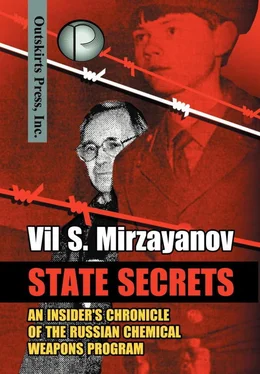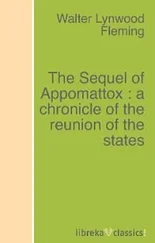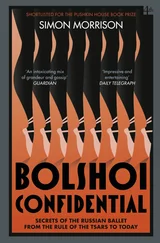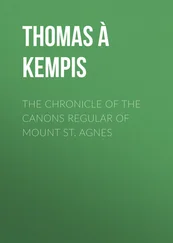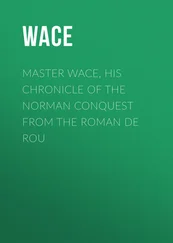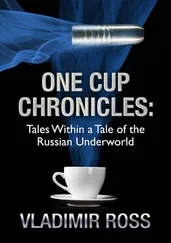At that time, the question of how the verification of the CWC would work in the future was a great problem in the negotiations. The majority of the delegations, including the U.S. and the U.S.S.R., supported conducting remote inspections, without visiting the actual plants. So the analysis of emissions of the ventilated air, sewage, and other waste became very important. That is why highly precise and sensitive methods of analysis of chemical compounds played a crucial role. Mainly the emphasis was on looking for organic phosphorus compounds that had a direct chemical bond between carbon and phosphorous atoms (C-P bond). But it wasn’t difficult to circumvent the inspection process. Chemical products with the same bond could be produced for civilian applications at the same facilities producing organophosphorus-based chemical agents. So, units producing phospoliols with the C-P-connection, which were used as metal-extracting agents, started operating at GOSNIIOKhT and its subsidiaries.
Later on, common sense prevailed in Geneva, and the CWC was signed in the beginning of 1993, stipulating on-site inspections as a normal control procedure. [69] Ralph Trapp, Verification under the Chemical Weapons Convention: On-Site Inspection in Chemical Industry Facilities (Oxford University Press, Stockholm International Peace Research institute (SIPRI), 1993).
, [70] International Inter-Laboratory Comparison (Round-Robin) Test for the Verification of Chemical Disarmament. F.4. Validating of Procedures for Water and Soil Samples (Helsinki: The Ministry for Foreign Affairs of Finland, 1993).
However, the development of the more toxic chemical agent A-232, in which the carbon atom is bonded to the phosphorous atom through the oxygen atom (C-O-P bond), considerably complicated the control process. My point is that many agricultural chemicals, which are produced at ordinary chemical plants, have the same bonds.
Many people supposed that it would be a great way to get rid of the old junk, while the new developments would be kept secret and would become the basis for a new round of competition in the field of chemical weapons. Nobody doubted that the U.S. would do exactly the same thing.
I am almost certain that the entire policy and strategy of negotiations in Geneva were developed at UNKhV (Administration of the Commander of the Chemical Troops), and General Anatoly Kuntsevich monitored this process. No one should be misled by the fact that he didn’t take part in the negotiations personally.
The ruse was based on the “dual-use” compounds which were the precursors for ordinary agricultural and other civilian chemicals, but could also be used as precursors for producing chemical agents. When a new chemical agent is being developed, a corresponding civilian preparation is also being developed, for example a pesticide. That is the game.
The development of binary nerve agents will make it unnecessary to organize the dangerous production of chemical agents, as they do for example at the Novocheboksary plant. It makes the problems connected with producing, equipping, storing, and transporting the warheads much easier. The most important point is that any potential violator of the CWC can use some civilian facilities for production, and those factories could be completely unaware that they are producing precursors for lethal binary weapons.
These ideas became really clear to me when I saw the formula of a new pesticide, which was similar to the formula of agent A-232 on a poster, which was hanging on the wall opposite the Directorate. Boris Martynov who was standing nearby boasted that he was “covering his product” in this way. The poster with the formulas of pesticides developed at GOSNIIOKhT and other institutes was meant as a widespread advertisement of the institute’s products. At the same time, the idea was for specialists to “become accustomed” to them as to civilian products.
Quite accidentally, I also soon learned about a strange but significant incident, the meaning of which became clear to me later on.
The typing bureau where secret materials were printed or taped didn’t accept a report prepared by our department on the problems of the PD ITR. The explanation was that the bureau was urgently retyping all technical documentation of the Novocheboksary plant that produced the chemical agent known as Substance 33. It turned out that the report was altered to pretend that they were producing VX gas. This was funny and sad, and I had no idea how they could possibly play the international inspectors for such fools. They were supposed to come to the plant and make sure that a specific chemical agent was being destroyed, not some theoretical agent. Apparently there was something in the strategy of negotiations that allowed them to hope that this trick might work.
At that time I didn’t understand the main idea behind this whole undertaking. Later on when I was released from the KGB’s Lefortovo prison after my first arrest, I called my friend, the late Leonid Lipasov, and he told me about a mistake that I had made in my article “A Poisoned Policy” ( Moscow News from September 16, 1992). Only then did I realize how far-sighted the masters of the military-chemical complex had been. In my article I said that General Kuntsevich and others had received the Lenin prize in 1991 for the development of binary weapons based on a new substance. Actually, that turned out not to be the case. Instead, they got the prize for binary weapons based on the well-known Novocheboksary agent Substance 33! The tricky juggling and revision of documents from the Novocheboksary plant was a part of that whole operation.
It would be naive to assume that the generals from the military industrial complex (VPK) did all this just to receive prizes. Everything was done according to a plan that had been elaborated beforehand, a plan that was coordinated with the strategy for conducting negotiations on the framework of the CWC. In the summer of 1995, I met with Amy Smithson a Senior Fellow and now PhD, who was working at the Henry L. Stimson Center in Washington, D.C. I was preparing an article for a collection to be published. In my article, I alleged that, according to the Wyoming Memorandum, the parties were supposed to exchange the formulas of their chemical agents, subject to destruction at the second stage of the implementation of this accord. The well known American, Professor Matthew Messelson rebuked me for an inaccuracy. Actually, the parties were supposed to exchange this information three months before signing the CWC, but Russia didn’t come forth with this information.
The main task of the PD ITR Department was made very specific then. It was necessary to keep all new projects a secret. In order to accomplish this, we had to quickly develop more sensitive techniques for the determination of traces quantities of chemical agents in the waste water and air.
In 1989 this work was accelerated because American specialists were soon supposed to visit a number of chemical establishments connected with the development and production of chemical agents. A committee headed by Guskov was formed to prepare for this, and I became a member of this committee.
The necessary techniques were to be developed on an emergency schedule, over the course of about two months. I asserted that it was impossible to develop techniques that were a hundred times more sensitive than the current ones, in such a short period of time. I was puzzled why there should be such a rush before the arrival of specialists, if they were not going to take samples of the water and air. With quite a serious air, Guskov explained that when the foreign specialists came into the room they could take a “swab” from the surface of the wall or floor with their handkerchiefs and then “decipher” the new compounds at home. I made an effort not to burst out laughing. That was how our heads imaged the work of foreign technical intelligence! Science couldn’t and still can’t disclose secrets in such a fantastic way.
Читать дальше
